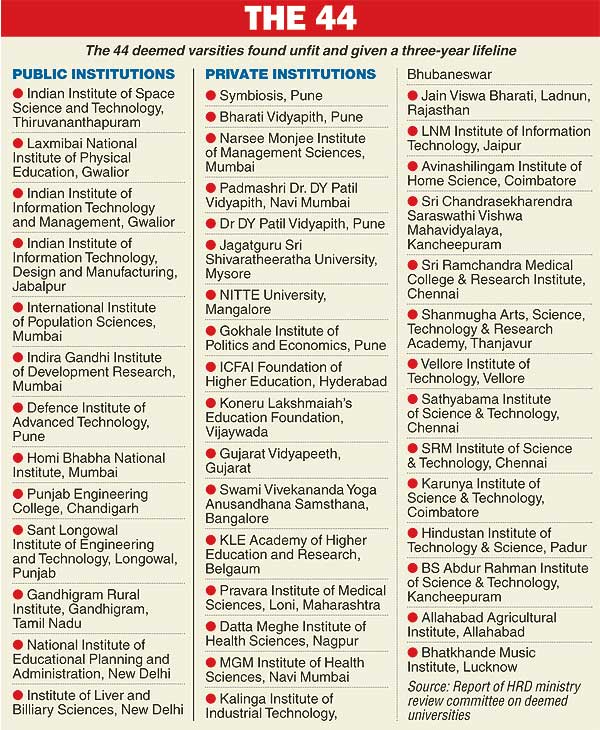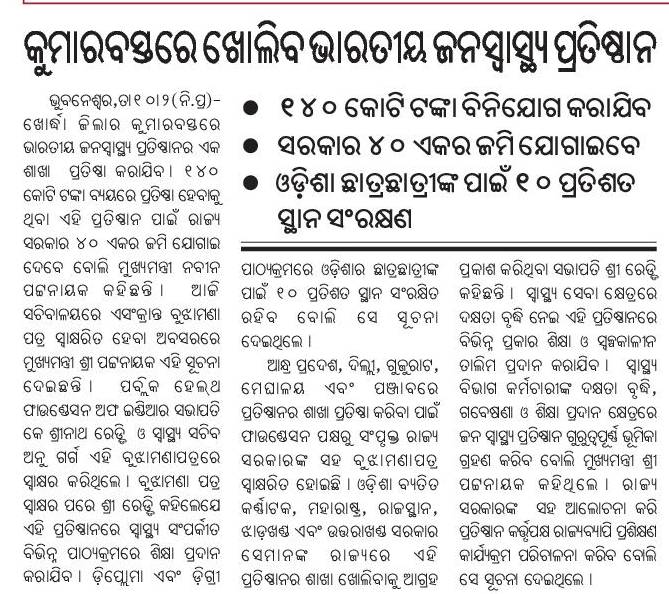Progress on ESIC medical college – Expected to be operational in 2012: Samaja

February 14th, 2010
Thanks to Rahul Barik for the pointer. The Telgraph article is at http://telegraphindia.com/1100214/jsp/nation/story_12104169.jsp. Following is the graphics from that web site.

1 comment February 14th, 2010
Update: Following is from Samaja.

Following is from a report in Pioneer.
The State Government has decided to set up a technical university in Sambalpur. This university would be christened as Sambalpur University Institute of Information Technology. The State Government has provided Rs 10 crore for this institute.
The Pioneer news above is a bit inaccurate. As far as I know it will be a part of Sambalpur University. The idea was mooted by Sambalpur University VC (who was earlier a Computer Science professor at University of Hyderabad) Prof. Arun Pujari. I have seen part of the proposal. Prof. Pujari had a very good proposal. His proposal and persistent efforts to get it approved finally got enthusiastic support from the IT Secretary Mr. Pradipta Mahaptra, the RDC and the Additional Chief Secretary Mr. S. P. Nanda and higher education officials (HE Secretary Mr. M. Padhi and others) and ministry. Kudos to all of them.
With the establishment of this Odisha will soon have three IIIT type institutes in Bhubaneswar, Berhampur and Sambalpur.
Special thanks to Prof. Arun Pujari. He has several other innovative plans for Sambalpur University. He has also made some very good hires in the Science disciplines at Sambalpur University. If he continues at the current rate he will be remembered as one of the best VCs of Sambalpur University. Lets support his innovative initiatives with all our heart.
17 comments February 11th, 2010
Update3: From Samaja – 10% seats will be reserved for students from Odisha.

Update2: From Dharitri
Update: Business Standard has more details on this. Following are some excerpts.
Speaking on the occasion, Patnaik said, … “IIPH, in consultation with the state government, will impart training programmes for enhancing the capacity of the public health functionaries across all levels. The institute will offer Post-Graduate diploma programmes in Public Health Management, Health Economics, Health Care Financing, Health Policy, Biostatistics and Data Management. In addition, IIPH will conduct two-year diploma course in Public Health and Masters in Public Health”, he added.
… Reddy, the PHFI president, said, “Once the IIPH campus is fully operational, it will offer training short-term training programmes to 500 people and long-term training to 300 others.
As per the IIPH web pages currently the following courses are offered by the existing IIPHs.
Earlier when it was announced that PHFI centers will open in Bhubaneswar and Balasore it was not clear what kind of center it would be. (See also here and here.) Following is an excerpt from a PTI report that says an IIPH will start in Bhubaneswar this July.
Orissa will soon get an Indian Institute of Public Health (IIPH) here which will start functioning from July this year.
An MoU in this regard was signed between the state government and the New Delhi-based Public Health Foundation of India (PHFI) for establishment of an IIPH here at an investment of Rs 140 crore.
"The institute will deal in education, training and research on prioritised health problems of the state," Chief Minister Naveen Patnaik said while attending a function on the occasion.
While the state government had agreed to give 40 acres of land free of cost at Kumarbasta village near here to establish the IIPH, the PHFI would invest the money for the purpose, Patnaik said.
Considering the real need with respect to containing Cholera, Malaria and other diseases that frequently break out in the hinterlands the IIPH in Bhubaneswar must establish branches in the hinterlands of Odisha.
2 comments February 10th, 2010
I stumbled across this institute in the web. Its home page is at http://euclidtmp.com/index.html. The teacher at this institute is Mr. S. B. Panigrahi. Although it seems to admit students that have done very well in their earlier exams, the overall result of the institute sounds very good.
As per the page http://euclidtmp.com/our-achievements.html over the period of 9 years from 2001 to 2009 this institute has created:
Since this institute seems to only cover Maths, the above student must have had good background and/or good mentoring in Physics and Chemistry. Nevertheless, from the above results and the tributes paid by the EUCLID alumni this institute seems to be a good place in Bhubaneswar to get coached in Mathematics at the plus 2 level.
1 comment February 10th, 2010
Following is an excerpt from his speech transcript in Business Standard.
It is in this dreary world of higher education in India that we have shining examples, such as St Xavier’s College. It was founded by the Society of Jesus. Long before Shri Maulana Abul Kalam Azad, Dr S Radhakrishnan, Dr Zakir Hussain, Dr Humayun Kabir and my good friend Shri Kapil Sibal, there was an intrepid soul named Fr H Depelchin. Along with six Belgian Jesuits, he arrived in Kolkata and founded the St Xavier’s College.
The college has been in the service of the nation for 150 years. Not only in Kolkata, but in many other parts of India, the Society of Jesus has rendered yeoman service to the cause of education. Its 153 high schools, 38 university colleges, 14 technical institutes and five business administration institutes teach, at any given time, over 230,000 students belonging to every section of the society. St Xavier’s alone has over 4,000 students.
Like every Jesuit educational institution, St Xavier’s College has an admission policy that is biased in favour of the poor, especially the socially and financially marginalised, and I commend the college on its sense of social responsibility. We are beholden to the Jesuits for the unwavering dedication, the sense of duty, and the strict discipline they bring to their work and to the institutions founded by them.
I passed through a Jesuit institution and I fondly remember the great teachers: Fr Murphy, Fr Sequira, Fr Coyle, Fr Lawrence Sundaram, Fr Amascua and Fr Yedanapally. It surprises me even today how so many of them could leave such an indelible impression in a period of barely one year.
We are still debating the norms and values that must prevail in an institution of higher learning, and especially the place of the non-government sector in providing higher education. I recognise and support the role of the private sector in higher education, but I am absolutely clear in my mind that the private sector in higher education ought not to mean private business in higher education. As far as I am aware, no great university in the world was established for the purpose of profit. I believe that some activities in a society must stand outside the world of profit and higher education, in my view, ranks first amongst such activities.
For over 150 years, the Society of Jesus has done just that in Kolkata, in Chennai and in many other towns and cities. For that and for many other blessings that they brought to India, we thank them and we salute them.
(Excerpts from Home Minister P Chidambaram‘s valedictory address at St Xavier’s College (Autonomous) in Kolkata on January 17, 2010)
The above is very relevant to the proposal of a Xavier University in Odisha. The Odisha government should expedite that proposal.
3 comments February 7th, 2010
There are 48 manuscript resource centres and 33 manuscript conservation centres in India. The list is given at http://pib.nic.in/release/release.asp?relid=57547. The ones in Odisha are as follows:
Two manuscript resource centers:
|
32 |
|
|
|
|
33 |
Sanskrit Academy of Research for Advanced Society Through Vedic & Allied Tradition of India (SARASVATI),Sarasvati Vihar, Barpada, Bhadrak – 756 113 Orissa. |
|
Three manuscript conservation centers:
|
23 |
INTACH |
|
|
|
24 |
AITIHYA Plot No. 4/330, 1st Floor, Raghunathpur, P.O.Sisupala Gada (Near |
|
|
|
25 |
|
|
February 6th, 2010
1 comment February 1st, 2010
I was discussing with several people associated with NISER Bhubaneswar. I was told that the NISERs and IISER are having difficulty finding good faculty in mathematics, especially in pure mathematics. (On the other hand they can find very good people in Physics, Chemistry and Biology.) I did a quick survey of the IISERs and NISER and indeed they have much more faculty in Physics, Chemistry and Biology than in Mathematics. Following is a rough count made on Jan 30, 2010.
|
Physics |
Chemistry | Mathematics | Biology | Others | Total | |
| IISER Kolkata | 20 | 19 | 3 | 7 | 7 | 56 |
|
(some have joint appointments) |
11.5 (includes 3 joint) |
14 |
7 (includes 2 joint) |
13.5 (includes 3 joint) |
0 | 46 |
|
(permanent + visiting) |
12 (7 + 5) | 15 (10 +5) | 9 (5 +4) | 15 (7+8) | 4 (0+4) | 55 |
|
(permanent + visiting) |
8 + 2 | 9.5 | 4 + 1 | 8.5 | 0+1 | 34 |
|
(Current + to join in June 2010) |
6 + 1 (includes 1 visiting) | 13+1 | 4 (includes 1 visiting) | 5+2 | 2 (includes 1 visiting) | 34 |
|
(Current + to join in June 2010) |
4+5 | 5 | 2 | 2+1 | 19 |
As evident from the above, all of the above institutes are struggling in hiring faculty in Mathematics. Also, while the young faculty in the other fields (Physics, Chemistry and Biology) mostly have post-doc experiences, most of the younger Math faculty do not have that experience.
One of the reasons behind the shortage of Math Ph.ds is that most people who love Mathematics in high school go on to pursue engineering and perhaps there is a mistaken impression that the career prospects in mathematics is not good. Thus there is a big need for institutions like
The Institute of Mathematics and applications, Bhubaneswar
which is making great efforts to popularize Math among youngsters.
I hope some of the people who loved Math in high school, and now are in other (say IT) jobs would consider pursuing Math. Some of the top places to pursue Ph.D in Mathematics in India are:
India could also consider hiring foreigners. At least in the USA many Math Ph.Ds from top schools do not get a tenure track faculty position and end up teaching in community colleges. Some of them may jump at an opportunity to be a faculty in IISERs, NISER and other institutions.
3 comments January 30th, 2010
Following are excerpts from a report in Times of India.
In its revised concept note on the setting up of 14 Innovation Universities, the HRD ministry has proposed two types of reservation policy for these institutions, some of which will be directly funded by the government while a few will be in the PPP mode.
Within PPP, it has been proposed that world class universities from abroad might also be invited to set up similar such institutes here. The government will be a partner in the establishment and research programme while the cost of teaching will be funded by the promoter university.
The Innovation Universities fully-funded by the government will follow the existing reservation policy in admission for SCs/STs/OBCs. The Central Educational Institutions (Reservation in Admission) Act, 2006, will be applicable in their case.
However, in case of Innovation Universities in PPP mode, the HRD note says affirmative action cannot be wished away. Therefore, it has been suggested to weight the test scores with a measure for the socio-economic background of the candidates. …
There has also been a slight modification about auditing of accounts. While the money spent by a university or faculty on research or teaching will be kept out of the purview of Comptroller and Auditor General, the expenditure on administration or non-academic areas will be audited by CAG.
Two modes of establishment of Innovation Universities have also been decided. While those fully-funded by the government will come up through an Act of Parliament, the ones through PPP will be established through a Memorandum of Understanding. Financial, academic and research credentials of the private promoter will be the main criterion in selecting them to collaborate with the government.
The Innovation Universities will also have the freedom to decide on their own admission policy.
The 14 Innovation Universities will come up in Amritsar, Greater Noida, Jaipur, Patna, Guwahati, Kolkata, Bhopal, Kochi, Gandhinagar, Coimbatore, Mysore, Pune, Vishakhapatnam, Bhubaneswar.
January 30th, 2010
Update on Jan 25 2010: As per this news item:
The Supreme Court Monday restrained the central government from derecognising 44 deemed universities for their questionable academic performance or poor infrastructure and assured tens of thousands of their students of a fair hearing.
A bench of Justices Dalveer Bhandari and A.K. Patnaik ordered status quo for various deemed universities on several lawsuits by the varsities challenging the government’s move to derecognise them.
‘Nothing is going to happen to your institutions and your students till we dispose the matter,’ observed Justice Bhandari while also issuing notices to all 44 universities separately to have their say in the matter.
The case was adjourned to March 9.
The list is given in this TOI news item. Thanks to the people who sent the pointer.
72 comments January 19th, 2010
Following is an excerpt from a report in Business Standard.
IIT-Kharagpur plans to start by setting up a centre of excellence on Energy Science and Engineering to train students in research and development on various energy verticals like bio-energy, solar energy, nuclear, as well as hydel and thermal energy. …
The institute is also introducing new engineering programme on design and manufacturing where it aims to create globally competent engineering products. It will start School of Entrepreneurship soon where it will offer dual degree in BTech and entrepreneurship programmes. Students will be selected through joint entrance examination (JEE).
“The Innovation Centre will be funded by one of our alumnus, S K Bhattacharya. Each student of School of Entrepreneurship will be attached to an innovation centre. Each student will get a faculty and a successful alumnus entrepreneur to assist him or her. Our aim is to have around 30 per cent of our total student to be PhDs and researchers by 2015, compared to 15 per cent right now,” says Acharya.
An innovation centre is a new concept through which IIT-Kharagpur intends to encourage research and innovation. “We will have support from international institutions and industries to draw on their expertise and develop products of global use. So, for instance, we are collaborating with Warwick Manufacturing Group, Georgia Institute of Technology, Eindhoven University of Technology, among others,” adds Acharya.
Among international collaborations, IIT-Kharagpur is looking at specific areas of collaboration with National University of Singapore for water policies and issues. Also, the institute has signed an agreement with University of California, San Diego, for a 350-700 bed medical college. The collaboration is both for part-financing the project as well as an academic collaboration.
January 11th, 2010
Following is an excerpt from a PTI report on this.
Sibal said the government wants to set up 14 innovation universities on various themes and these institutions will earn revenue from various areas, including research.
Brown, however, differed from Sibal on the proposed economic model for the Innovation Universities and said that major funding will have to come from tuition fee.
"This is not going to work. In our university, 50 percent of revenue comes from tuition fee despite the university having a billion dollar of Endowment fund. The universities here will have to depend on tuition fee," he said.
Sibal retorted back, saying that the investment involved in setting a university in India will be less than the cost in the US.
He said institutes should not be charge exorbitantly on students. They can generate revenue from other sources.
The government will set up a Higher Education Finance Corporation to provide funding to poor students for study. The students can pay back the money over a period of time, he said. The HRD Ministry has prepared a bill to set up the corporation.
The loans will be made available for students pursuing professional courses, he said.
I am a bit confused about the innovation universities being on various themes. I thought they were supposed to be multi-dsiciplinary universities aiming to become like Oxford, Cambridge and Berkely.
January 10th, 2010
| M | T | W | T | F | S | S |
|---|---|---|---|---|---|---|
| 1 | 2 | 3 | 4 | 5 | ||
| 6 | 7 | 8 | 9 | 10 | 11 | 12 |
| 13 | 14 | 15 | 16 | 17 | 18 | 19 |
| 20 | 21 | 22 | 23 | 24 | 25 | 26 |
| 27 | 28 | 29 | 30 | 31 | ||